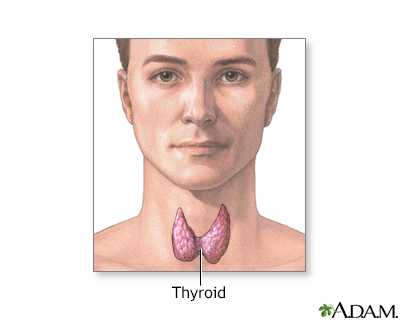Pregnancy SmartSiteTM
Thyrotoxic storm; Thyrotoxic crisis; Hyperthyroid storm; Accelerated hyperthyroidism; Thyroid crisis; Thyrotoxicosis - thyroid storm DefinitionThyroid storm is a rare life-threatening condition of the thyroid gland. It develops in cases of untreated hyperthyroidism, or overactive thyroid (thyrotoxicosis). The thyroid gland is located in the neck, just above where your collarbones meet in the middle. CausesThyroid storm occurs in people with uncontrolled hyperthyroidism due to a major stress such as:
Rarely, thyroid storm can be caused by radioactive iodine therapy for Graves disease. This can occur even a week or more after treatment. SymptomsSymptoms are severe and may include any of the following:
Exams and TestsYour health care provider may suspect thyrotoxic storm based on:
Blood tests are done to check the levels of the thyroid hormones TSH, free T4 and T3. Other blood tests are done to check heart and kidney functions and to check for infection. Liver function tests provide added diagnosis and treatment information. TreatmentThyroid storm is a medical emergency. It is life threatening. Often, the person needs to be admitted to the intensive care unit. Treatment may include:
The goal of treatment is to decrease thyroid hormone levels in the blood. Sometimes, high doses of iodine is given to try and stun the thyroid. Other medicines known as thionamides may be given to lower the hormone level in the blood. Beta blocker medicines are often given by vein (IV) to slow the heart rate, lower blood pressure, and block the effects of the thyroid hormone excess. In some severe cases, glucocorticoids (steroids) are given. Antibiotics are given in case of infection. Possible ComplicationsIrregular heart rhythms (arrhythmias) may occur. Heart failure and fluid in the lungs (pulmonary edema) can develop rapidly and cause death. When to Contact a Medical ProfessionalThis is an emergency condition. Call 911 or the local emergency number if you have hyperthyroidism and experience symptoms of thyroid storm. PreventionTo prevent thyroid storm, hyperthyroidism should be treated. ReferencesHollenberg A, Wiersinga WM. Hyperthyroid disorders. In: Melmed S, Auchus RJ, Goldfine AB, Koenig RJ, Rosen CJ, eds. Williams Textbook of Endocrinology. 14th ed. Philadelphia, PA: Elsevier; 2020:chap 12. Pearce EN, Hollenberg AN. Thyroid. In: Goldman L, Cooney KA, eds. Goldman-Cecil Medicine. 27th ed. Philadelphia, PA: Elsevier; 2024:chap 207. Thiessen MEW. Thyroid and adrenal disorders. In: Walls RM, ed. Rosen's Emergency Medicine: Concepts and Clinical Practice. 10th ed. Philadelphia, PA: Elsevier; 2023:chap 117. Weetman AP, Kahaly GJ. Graves disease. In: Robertson RP, ed. DeGroot's Endocrinology. 8th ed. Philadelphia, PA: Elsevier; 2023:chap 71. | |
| |
Review Date: 2/28/2024 Reviewed By: Sandeep K. Dhaliwal, MD, board-certified in Diabetes, Endocrinology, and Metabolism, Springfield, VA. Also reviewed by David C. Dugdale, MD, Medical Director, Brenda Conaway, Editorial Director, and the A.D.A.M. Editorial team. The information provided herein should not be used during any medical emergency or for the diagnosis or treatment of any medical condition. A licensed medical professional should be consulted for diagnosis and treatment of any and all medical conditions. Links to other sites are provided for information only -- they do not constitute endorsements of those other sites. No warranty of any kind, either expressed or implied, is made as to the accuracy, reliability, timeliness, or correctness of any translations made by a third-party service of the information provided herein into any other language. © 1997- A.D.A.M., a business unit of Ebix, Inc. Any duplication or distribution of the information contained herein is strictly prohibited. | |

 Thyroid gland
Thyroid gland
